ZEN MESTEREK ZEN MASTERS
« Zen főoldal
« vissza a Terebess Online nyitólapjára
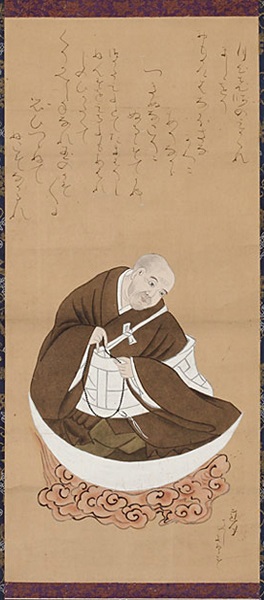
大田垣莲月 Ōtagaki Rengetsu (1791-1875)
Tartalom |
Contents |
Válogatás Ótagaki Rengecu alkotásaiból Otagaki Rengecu versei |
Links:
|
Ōtagaki Rengetsu (太田垣 蓮月, 10 February 1791 – 10 December 1875) was a Jōdo Shinshū (浄土真宗, "True Pure Land School") Buddhist nun who is widely regarded to have been one of the greatest Japanese poets of the 19th century. She was also a skilled potter and painter and expert calligrapher.
Born into a samurai family with the surname Tōdō, she was adopted at a young age by the Ōtagaki family. She was a lady in waiting at Kameoka Castle from age 7 to 16, when she was married. However, her husband died in 1823. Ōtagaki joined the temple Chion-in and became a nun, taking Rengetsu ("Lotus Moon") as her Buddhist name. She remained at Chion-in for nearly ten years, and lived in a number of other temples for the following three decades, until 1865, when she settled at the Jinkō-in where she lived out the rest of her life.
Though best known as a waka poet, Rengetsu was also accomplished at dance, sewing, some of the martial arts, and Japanese tea ceremony. She admired and studied under a number of great poets including Ozawa Roan and Ueda Akinari, and later in her life became a close friend and mentor to the artist 富岡鉄斎 Tomioka Tessai (1837-1924). A number of Tessai's works, though painted by him, feature calligraphy by Rengetsu.
Bibliography
Lotus Moon: the Poetry of the Buddhist Nun Rengetsu, tr. and with notes by John Stevens, Weatherhill (Inklings), 1994 & White Pine Press, 2005,
Paperback: Rengetsu: Life and Poetry of Lotus Moon Paperback, 2014Black Robe, White Mist, Art of the Japanese Buddhist Nun Rengetsu, by Melanie Eastburn and others, National Gallery of Australia, 2007; University of Washington Press, 2008
'Otagaki Rengetsu: Springs of Tim Past,' The Hughes Gallery, Sydney, 2011
Otagaki Rengetsu: Poetry & Artwork from a Rustic Hut Hardcover by John Walker & Kazuya Oyama, Large Print, 2014, www.rengetsu.org
Otagaki Rengetsu (1791~1875) http://www.rengetsu.com/
Art (Paintings, Calligraphy, Album, Sakeware, Teaware, Collaboration)
Poems 1~917 (Eglish / 日本語 / Romaji)
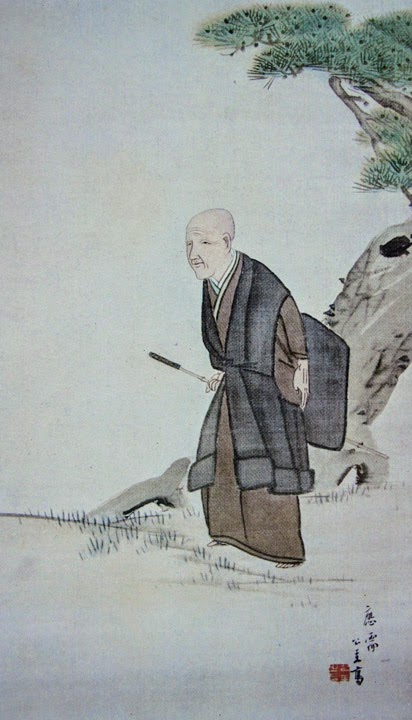
Rengetsu, age 81 by Ueda Kokei
Ten Poems by Rengetsu
Translations by Kazuaki Tanahashi, Joan Halifax
https://www.upaya.org/teachings/zen-poems/
Autumn Moon
Fearing my past is exposed
to the moon,
I keep looking down
this evening.
Water in an Old Temple
Leaking from the rock
in an old temple,
water barely trickles -
the voice
of the lingering dharma.
Brush Doodling
Just playing
not doing
anything special -
the drawn traces
of an ink-soaked brush.
Snow on Water
I see it dust
the river wind
then vanish -
fragile snow over water
disappears from my sight.
Firefly in the Field
Even if a thought
of the firefly grass
dwindles,
it may light up as a firefly
in a remote field.
Heart
Drifting
like white clouds
from beginning to end -
a thing of mystery
is this heart.
Longing in the Wind
I await my beloved
who is not yet here.
The moon in the pines
and voice of the wind
provoke my longing.
Evening Plum Blossoms
The perfume of plum blossoms
reaches even the sleeves
of my ink-dyed robe -
my aching heart
penetrates the evening.
My Wish Under the Moon
How I wish
to die in autumn
moonlight
not to be lost,
even in darkness.
Death Poem
My wish is to see
a cloudless moon
above the lotus flower
in my next life.
Otagaki Rengetsu, (1791-1875), is a Buddhist nun who is regarded as one of Japan's greatest waka poets of the 19th century. Betrothed at age 17, a son was born to her but died a short time later. There followed the birth of two daughters, who also died at a young age. Shortly before her second daughter died, Otagaki-san separated from her husband, who was a drunkard and a gambler, and who also died that same year. She was to find happiness in her second marriage, only to experience tragedy once again when he died of a sudden illness. At age 33, she gathered her strength and will to survive, shaved her head and took vows as a Pure Land Buddhist nun taking the name Rengetsu, “Lotus Moon.”
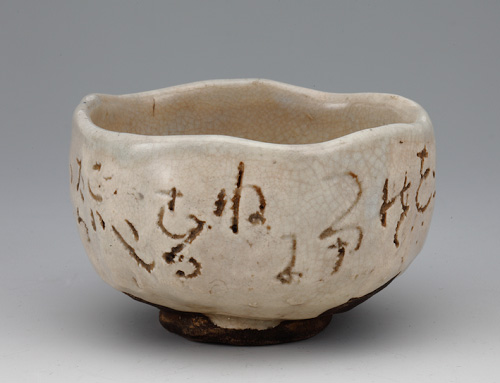
After staying for a decade at a Chion'in hermitage, Rengetsu left to begin a new life in Okazaki, near Kyoto. In her late forties Rengetsu began making tea ceramics, inscribing them with her own poems in her distinctive calligraphic hand. It is for this remarkable combination of pottery, poetry and calligraphy that Rengetsu is best known. The pieces were cheaper than ceramics produced by professional potters in Kyoto and quickly gained a following. Rengetsu became so popular she regularly moved to avoid the pressures brought by her reputation. In 1865 she settled at
Jinkō-in, the Temple of Divine Light and produced the majority of her life's work in a very productive period.
Rengetsu was also accomplished at dance, sewing, some of the martial arts, and Japanese tea ceremony. She admired and studied under a number of great poets including Ozawa Roan and Ueda Akinari, and later in her life became a close friend and mentor to the artist Tomioka Tessai. A number of Tessai's works, though painted by him, feature calligraphy by Rengetsu.
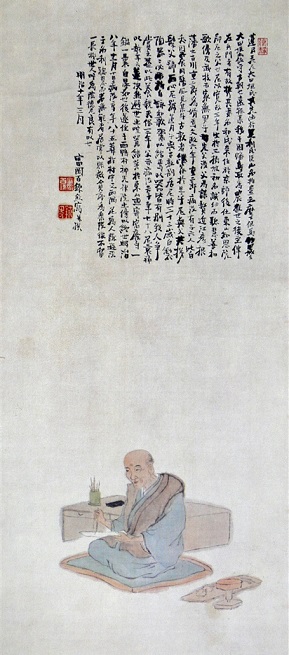
Portrait of Rengetsu by 富岡鉄斎 Tomioka Tessai (1837-1924)
http://www.muian.com/muian11/11tessai01.html
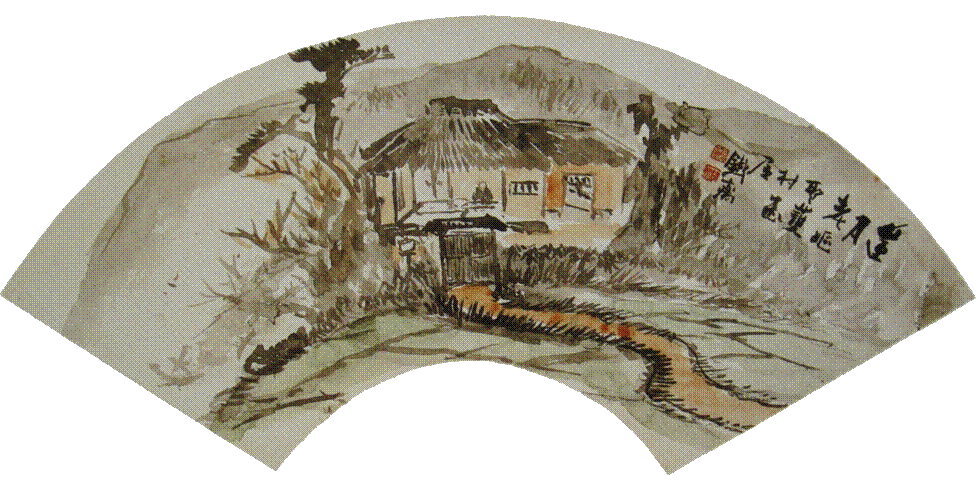
The Venerable Nun Rengetsu in her Hermitage in Shogo Village
by Tomioka Tessai
http://rengetsu.robynbuntin.com/2012/10/tessais-portrait-of-rengetsu/
Rengetsu is depicted in her hermitage brushing a poem on a tanzaku, with her potter's wheel to her right and her ceramic ware stacked on shelves in the hut next door. Shogo village is on the outskirts of Kyoto, home to Shogo-in temple, one of the main centers for yamabushi (mountain wizard) practice. The mountain village district surrounding the temple is considered sacred.
“Fluttering Merrily”, the same poem on painting and pottery by Ōtagaki Rengetsu
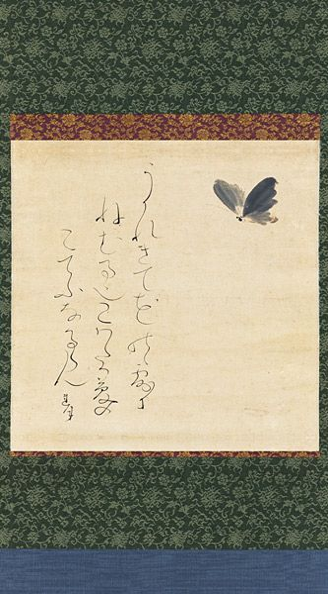
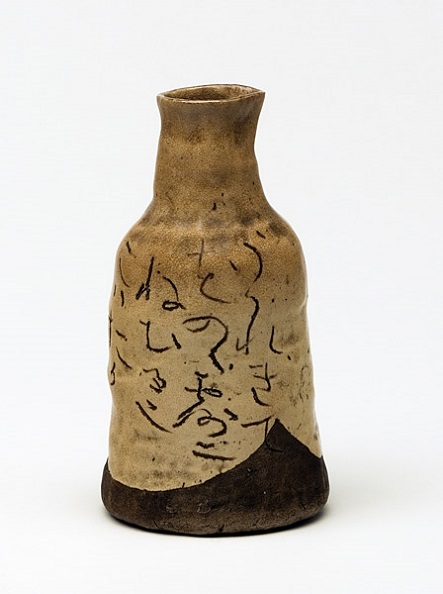
“Fluttering Merrily” 1840s–50s, calligraphy and painting in ink on paper mounted as a hanging scroll; Private Collection, Switzerland
“Fluttering Merrily” sake flask [tokkuri] 1870, glazed stoneware, incised calligraphy, 15.0 x 8.0 cm. Museum DKM/Stifung DKM, Duisburg, Germany
Cho
Ukarekite
Hanano no tsu ni
Neburu (nemuru) nari
Ko wa taga yume no
Kocho naruramuButterfly
Fluttering merrily and
Sleeping in the dew
In a field of flowers,
In whose dream
Is this butterfly?(trans. Kuniko Brown)
Válogatás Ótagaki Rengecu alkotásaiból
Fordította: Máthé Veronika
A Tan Kapuja Buddhista Egyház, Tájékoztató 41, 2008 ősz, 15-16. oldal
Ótagaki Rengecu (1791-1875) - Lótusz Hold - japán buddhista szerzetesnő, kalligráfus, költő és keramikus volt. Kalandos életéről és sokoldalú művészetéről bővebben a "Black Robe, White Mist" kiállítás kiadványában lehet olvasni. A fordítás angolból készült.
Festegetés
Játszani,
időzni
csak úgy -
a tusba mártott ecset
szántotta nyomok.A hold ősszel
Az őszi hold, félek,
kifürkészi múltam.
Ma este pillantásomat
a földre szegezem.Víz a templomban
A régi templomban
a sziklafalból víz
cseperészik -
az időtlen
Dharma szól így.Hó a víz felszínén
Látom, amint
a folyó feletti szélben
porzik, majd tovaszáll -
a finom hó a víz felett
eltűnik a szemem elől.Szív
Fehér felhőként
Sodródik
a kezdetektől a végig -
csupa rejtély
ez a szív.Szélfútta vágyakozás
Szerelmemre várok,
ki még nem érkezett meg.
A fenyők közt megbúvó hold
s a szél süvöltése
szítja vágyamat.
Otagaki Rengecu versei
Fordította: Szántai Zsolt
Haikuk és Wakák, Japán versek, Szukits Kiadó, Szeged, 2001
[A haiku formában fordított versek az eredetiben wakák. Rengetsu nem írt haikut. (Terebess szerk.)]
BETEGEN
Zuhatag üvölt,
vihar bömböl a hegyen;
vad folyó - hogy zúg!
Mind elmúlik vagy újra
hallom ezt új reggelen?ÚJ ÉV
A gerendákról
a sok kormot letörlöm,
söpröm a hamut,
feledem mi elmúlt.
Új évre készülődöm.
TAVASZ
Kósza gondolat -
a magány az, mi zavar,
de lelek vigaszt
ha látom az új tavaszt,
patak vizét, szirmokat.
ÚJ NAP
Hajnal született
magasan a víz felett.
A hegy hósipkás,
de a völgyben megindult
a friss, új átváltozás.IDŐ
Az idő múlik:
fűzfám ablakon zörget.
Már hároméves.BÉKA
Virágért nyúlok.
Béka vízbe ugrik -
így tiltakozik.
FAGY
Egy léket vágtam
tegnap; eltűnt - nem bírta
a hajnal fagyát.ŐSZI BÉKESSÉG
Őszi békesség:
szél kószál a fenyvesben,
tücsök hegedül.
imádkozni készülök
a kis, hegyi szentélyben.ŐSZ
Vadlúdcsapat száll.
búcsút int a meleg nyár.
Bús bogárcsapat
fák mellől, fű tövéből,
zümmög halk elégiát.
TISZTA HOLDFÉNYBEN
Tiszta holdfényben
bogarak kórusa zeng.
Sűrűbb az alkony,
hidegebb lett az este.
A széltől könnyem csorog.
DALLAM
Dallam, melódia;
házam mögött, fenyvesben
a szél énekel.
HAJNAL
A sötét az úr,
de a fák törzse mögött
már szól a tücsök.
TAVASZ
Új fény születik.
Magasan, fent a hegyen
vastag még a hó,
de tél jege megreccsent,
már szabad lett a folyó.
ÚJ VILÁG
Új világ, új fák,
levelek; kakukk kiált
az Uji hegyén.
KASE-HEGY
Tiszta fény, friss táj,
kakukkszó Kase-hegyen.
Ez útravalóm,
ez vigaszom, emlékem.
A fővárosba megyek.
SZIROM HA LEHULL...
Szirom ha lehull,
a szívem belesajdul -
búcsúzik a nyár.
SZILVASZIROM
A szilvaszirom -
illata a párnámat
is átitatja.
Fejem fölött vadludak.
Mélyül már az éjszaka.
ÉJ KÖZELG
Éj közelg, zordan.
Levélrejtekbe búvik
a kakukk hangja.
A REPEDÉSBŐL
A repedésből
kis hegyi kunyhóm falán
Tücsök rámkiált.
Hangja mellett vékonyan
a holdfény folyik, lágyan.